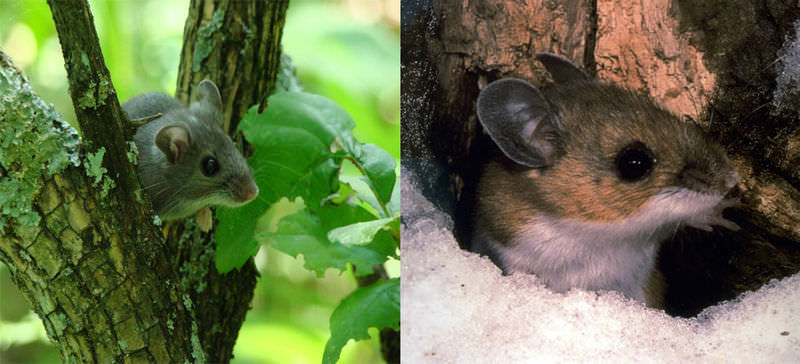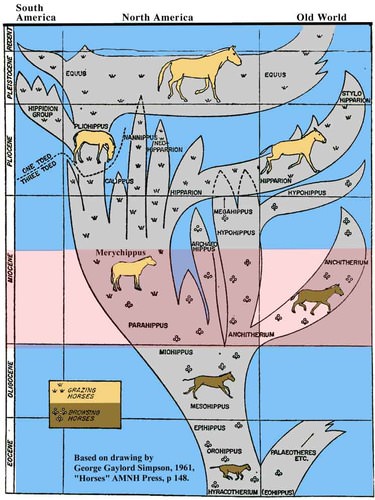自然选择进化论
章节大纲
-
How did dark deer mice become lighter over time?
::黑鹿小鼠如何随着时间的流逝变得较轻?A species changes color over time if its environment changes. Many other types of changes can take place, too. The darker deer mice evolved into the lighter deer mice in some locations. What do you think changed about the environment?
::当物种的环境发生变化时, 物种会随时间变化颜色。 许多其他类型的变化也会发生。 较暗鹿小鼠在某些地方演变成较轻鹿小鼠。 您认为环境会发生什么变化?Biological Evolution
::生物进化Genes in a species or population may change over time. These genetic changes can create adaptations , which may add up if the adaptation helps the organism survive in its environment. If the environment is stable , the species won't change. But if the environment is changing, the species will need to adapt. Many adaptations may be necessary. In time, the species may change a lot. The descendants will be very different from their ancestors. They may even become a new species. This process is called biological evolution but is usually referred to just as evolution .
::物种或种群中的基因可能随时间变化。 这些基因变化可以产生适应, 如果适应能帮助生物体在环境中生存, 这些基因变化可能会形成适应。 如果环境稳定, 物种不会改变。 但是如果环境正在变化, 物种将需要适应。 许多适应可能是必要的。 随着时间的推移, 物种可能会改变很多。 后代会与祖先有很大的不同。 它们甚至会变成一个新的物种。 这个过程被称为生物进化, 但通常被称为进化。Organisms alive today evolved from earlier life forms. We can learn about this from fossils . For example, horse fossils from 60 million years ago are very different from modern horses. Ancient horses were much smaller than they are today ( Figure ). The horses’ teeth and hooves have also changed. The horses evolved because of changes in their environment.
::当今活生生的生物从早期的生命形式中演变而来。 我们可以从化石中了解这一点。 比如,6000万年前的马化石与现代马匹非常不同。 古老的马匹比现在小得多(图 ) 。 马的牙齿和蹄子也发生了变化。 马的进化是由于环境的变化。Ancient horses were quite different from present-day horses. Although basic horse evolution appears to be linear, there were many more branches. Horse evolution is very well understood.
::虽然马的基本进化似乎是线性的,但还有更多的分支。马的进化是人们非常理解的。Natural Selection
::自然选择自然选择Evolution happens because of natural selection . Helpful traits become more common in a population. If a trait is harmful, it becomes less common. The deer mouse, species Peromyscus maniculatus gives an example of evolution by natural selection. In Nebraska, this mouse is typically brown. But in places where dropped lighter sand over the darker soil , the mice are light. Why? Because predators could more easily spot the dark mice on light sand. The lighter mice were more likely to survive and have offspring. Natural selection favored the light mice. Over time, the population became light colored. Enough changes may take place over time that the two types of mice become different species.
::进化是自然选择的结果。 帮助性特性在人群中变得更加常见。 如果特性是有害的, 就会变得不那么常见。 鹿鼠, 物种Peromyscus maniculatus 提供了自然选择进化的例子。 在内布拉斯加, 这只老鼠通常是棕色的。 但是在较暗的土壤上投下较轻的沙的地方, 小鼠是光亮的。 为什么? 因为捕食者更容易在浅沙上发现黑鼠。 较轻的小鼠更有可能生存, 并且有后代。 自然选择有利于光鼠。 随着时间的推移, 种群会变得较轻。 随着时间的推移, 变化可能已经足够了, 这两类小鼠会变成不同的物种。Summary
::摘要- Changes in the genes of a species may result in a new species. This is biological evolution.
::物种基因的变化可能导致新的物种,这是生物进化。
- Natural selection can change a species or even make a new species. Natural processes favor some traits over others in a population. This causes those traits to be more common in subsequent generations.
::自然选择可以改变物种,甚至创造新的物种。 自然过程有利于某些特性,而不利于人口中的其他特性。 这使得这些特性在后代人中更加常见。
- Evolution just means change over time.
::进化只是意味着随时间而变化。
Review
::回顾- Why are some deer mice brown and some lighter colored in Nebraska?
::为什么内布拉斯加州有些鹿鼠棕色和一些较轻的颜色?
- Using the example of the deer mice, how does natural selection explain the change with time of darker mice into lighter mice?
::以鹿鼠为例, 自然选择如何解释黑鼠时间变小鼠的变小小鼠?
- How does biological evolution work?
::生物进化如何运作?
Explore More
::探索更多Use the resource below to answer the questions that follow.
::利用以下资源回答以下问题。- How do identical twins, who should have exactly the same sets of genes (genome) end up with differences?
::如何使完全相同的双胞胎,即应当拥有完全相同的基因组(基因组)的双胞胎最终产生差异?
- How are genomes changed and passed on to offspring so that the offspring aren't genetically identical to one or the other parent?
::基因组如何改变 并传给后代 这样后代在基因上 与父母中的一方或另一方不完全相同?
- Changes in the genes of a species may result in a new species. This is biological evolution.

